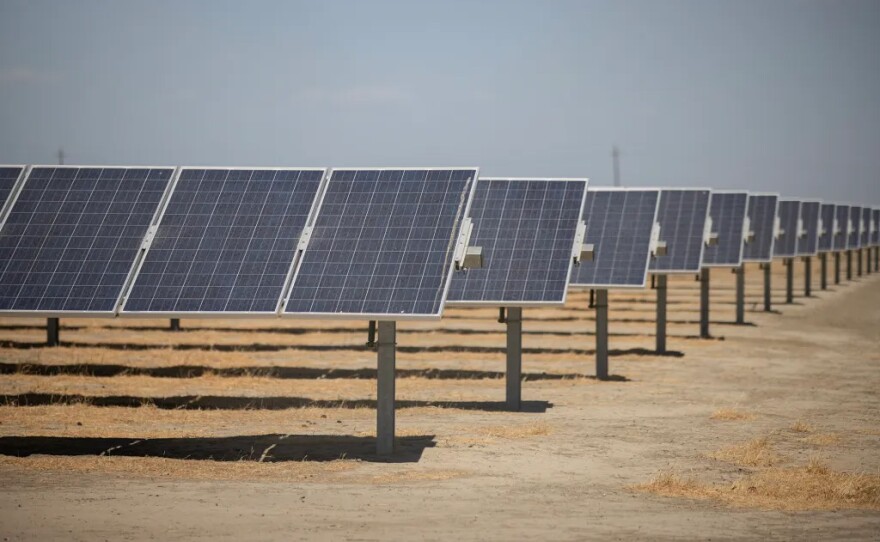This story was originally published by CalMatters. Sign up for their newsletters.
California’s drive to run its electric grid entirely on wind, solar and other clean sources of energy just got harder after President Donald Trump signed a sweeping new budget law.
The changes in federal tax incentives could affect the feasibility of new solar and wind projects as the state is counting on them to provide more electricity for Californians. A state law requires 100% of electricity to be powered by renewable, carbon-free sources by 2045, at the same time it’s moving to electrify cars and trucks.
Incentives championed by former President Joe Biden were rolled back, shortening the timeline for the industry to obtain tax credits. Developers of wind and solar projects now face a new, shorter deadline for obtaining tax credits — most now expire at the end of 2027 instead of no sooner than 2032.
In addition, the new federal rules bar companies from accessing tax credits if they rely on major components from China or other “foreign entities of concern.” This restriction could hit California’s solar and wind industry especially hard, experts said.
The changes to tax credits are estimated to save the federal government approximately $499 billion from 2025–2034.
“For too long, the Federal Government has forced American taxpayers to subsidize expensive and unreliable energy sources like wind and solar,” Trump wrote in an executive order last week. “The proliferation of these projects displaces affordable, reliable, dispatchable domestic energy sources, compromises our electric grid, and denigrates the beauty of our Nation’s natural landscape.”
Projects can still be built without tax credits. But it puts more of a financial burden on their investors. In California, 11 solar projects and one onshore wind project now face potential delays or cancellation, according to an analysis of federal data by Atlas Public Policy provided to CalMatters. The projects are spread across the Central Valley, Inland Empire and Northern California.
Sean Gallagher, senior vice president of policy for the Solar Energy Industries Association, said in a statement that the industry was still “assessing what the federal tax bill means for them.” He warned the changes could jeopardize up to 35,700 solar jobs and 25 solar manufacturing facilities in California — including existing positions and factories as well as future projects that may now never materialize.
“The reality is, with or without clean energy tax credits, California’s energy demand is growing at a historic rate, and solar and storage are the fastest and most affordable way to meet that demand,” Gallagher said.
California in recent years has been fast-tracking massive floating offshore wind farms 20 miles off the coasts of Humboldt County and Morro Bay. The federal changes add some uncertainty that could chill investment. But experts say it’s not a death knell for the industry because the projects weren’t set to seek federal permits or generate electricity for at least several years.
“Offshore wind is what we would call a long-lead project. It does take years and years to develop,” said Assemblymember Dawn Addis, former chair of the Assembly’s Offshore Wind Select Committee. “Solar is a little bit shorter of a time frame…but it’s also his incredibly erratic behavior when it comes to market stability overall that is also going to affect these projects in a negative way.”
Experts say in the long-run, the federal changes could drive up energy costs.
“Tax credit savings are typically passed onto ratepayers through lower contracting costs. In the long term, the repeal of the tax credits will result in higher future electricity rates for customers,” the California Energy Commission told CalMatters.
Rising utility bills are already a major political headache for state leaders and a challenge for clean energy advocates who want the state to lead the way in making electricity cleaner, cheaper, and more reliable.
“The whole point of California’s climate policy is not just to reduce California’s carbon footprint — because we are less than 1% of global emissions — but to set an example and show that this can be done,” Berkeley economist Severin Borenstein told CalMatters. “There are going to be fewer other states following our example because it’s going to be more expensive.”
The new hurdles for solar and wind come as they are scaling up to meet surging electricity demand nationwide, including from energy-hungry data centers fueling the rise of artificial intelligence.
California Energy Commissioner Nancy Skinner, in an interview with CalMatters, said the federal law is a national “job killer” and was short-sighted. “The economics of renewable energy generation speak for themselves....The cost of solar generation now is competitive with natural gas,” she said.
“We're not going to back away from our commitments and our goals,” she added. “Our commitment — whether it is to zero-emission vehicles, or to renewable energy generation — is about cleaning the air as well as addressing the climate crisis…Nobody wants to live in smoggy communities, where the air you're breathing hurts you.”
Solar and wind projects have helped California log key renewable energy milestones in recent years. Last week, Gov. Gavin Newsom said nine out of every 10 days so far in 2025 have been powered by non-fossil fuels for at least a part of the day.
"The economics of renewable energy generation speak for themselves....The cost of solar generation now is competitive with natural gas."California Energy Commissioner Nancy Skinner
The state’s grid runs on a mix of renewables — solar, wind, geothermal, nuclear, biomass and hydropower — an average of seven hours a day, the governor said, citing new data compiled by the California Energy Commission.
“The fourth largest economy in the world is running on more clean energy than ever before,” Newsom said in a statement. “Trump and Republicans can try all they want to take us back to the days of dirty coal but the future is cheap, abundant clean energy.”
But industry officials say the state isn’t doing enough. They say the state has too many hurdles for building wind and solar projects and needs to offer more funding.
“For years now, too many California leaders have retreated from true clean energy leadership — hopefully the tax bill serves as a wakeup call that their leadership on clean energy is more important now than ever,” Gallagher said.
Trump and Congress did not shorten the tax credit deadlines for nuclear power plants, hydroelectric facilities, battery storage and geothermal plants. Congress also dropped a provision that would have added a new excise tax on wind and solar.
For wind and solar, there's still a possible path to claim tax credits if construction starts within a year or they come online by the end of 2027. Senators added that provision to soften the blow. In theory, those projects could be finished and connected to the grid as late as 2031 and still qualify, but that depends on how the Treasury Department defines what it means to “start construction,” said Kevin Book, an energy analyst based in Washington, D.C.
“In the short-term, it might actually increase or shift earlier expenditure on these kinds of clean energy projects and all else equal,” said David Victor, a professor of public policy at UC San Diego. “California is in a pretty good position to profit from that acceleration.”
But Victor warned that the long-term costs could become “a political nightmare.”
“The long-term incentive, clearly, is to try to slow down investment in solar and wind and electric vehicles,” Victor said.

Borenstein took a more measured view about the impact on costs: California’s high electricity prices aren’t mainly about power production — they’re driven by wildfire costs, including past damage payouts and upgrades to prevent future fires. Other drivers include subsidies for low-income customers and the cost shift from rooftop solar, he said.
Some legislators have advocated for the state budget to cover more of these costs, but Borenstein said it’s politically easier to keep charging customers through their electric bills.
Alex Jackson, who leads the industry group American Clean Power California, said the state should use money from its cap-and-trade program to lower bills. Cap and trade is a market system that charges California companies for the greenhouse gas emissions they produce. Jackson said those funds could help pay for grid upgrades so ratepayers don’t have to.
He said the state also could lower clean energy costs by speeding up permitting, easing environmental rules for upgrades to existing projects and reducing costs for turning farmland into solar farms. He also called for expanding regional electricity markets to help California trade power more efficiently — a controversial idea being debated in the Legislature this year.
"We’ve really aggressively invested in clean energy, and we need to ramp up that investment, and we need to make it easier and faster to get clean energy deployed."State Sen. Scott Wiener
The state Legislature has debated for years exempting some clean energy projects from the state’s landmark environmental law, the California Environmental Quality Act, which is often blamed for delays. State Sen. Scott Wiener, of San Francisco, has advocated for such changes.
“California has always been a leader, and we need to step that up significantly,” Wiener told CalMatters. “We’ve really aggressively invested in clean energy, and we need to ramp up that investment, and we need to make it easier and faster to get clean energy deployed.”
In addition to the wind and solar credits, the budget signed by Trump also ends tax credits for purchase of electric cars, rooftop solar panels, home batteries, heat pumps, insulation, energy-efficient windows and doors, and other upgrades. Rooftop solar tax credits end this year. Federal tax credits for hydrogen production end after 2027 — a blow for California, which had positioned itself as a national hydrogen hub. Those changes are estimated to save about $543 billion from 2025–2034.
The state Energy Commission said the elimination of the EV credits beginning on Sept. 30 will mean "lower adoption of electric vehicles" and a "potential short-term spike in ZEV sales" before that date. Rooftop solar projects and heat pump sales also are likely to decrease, the agency said.
This article was originally published by CalMatters.






